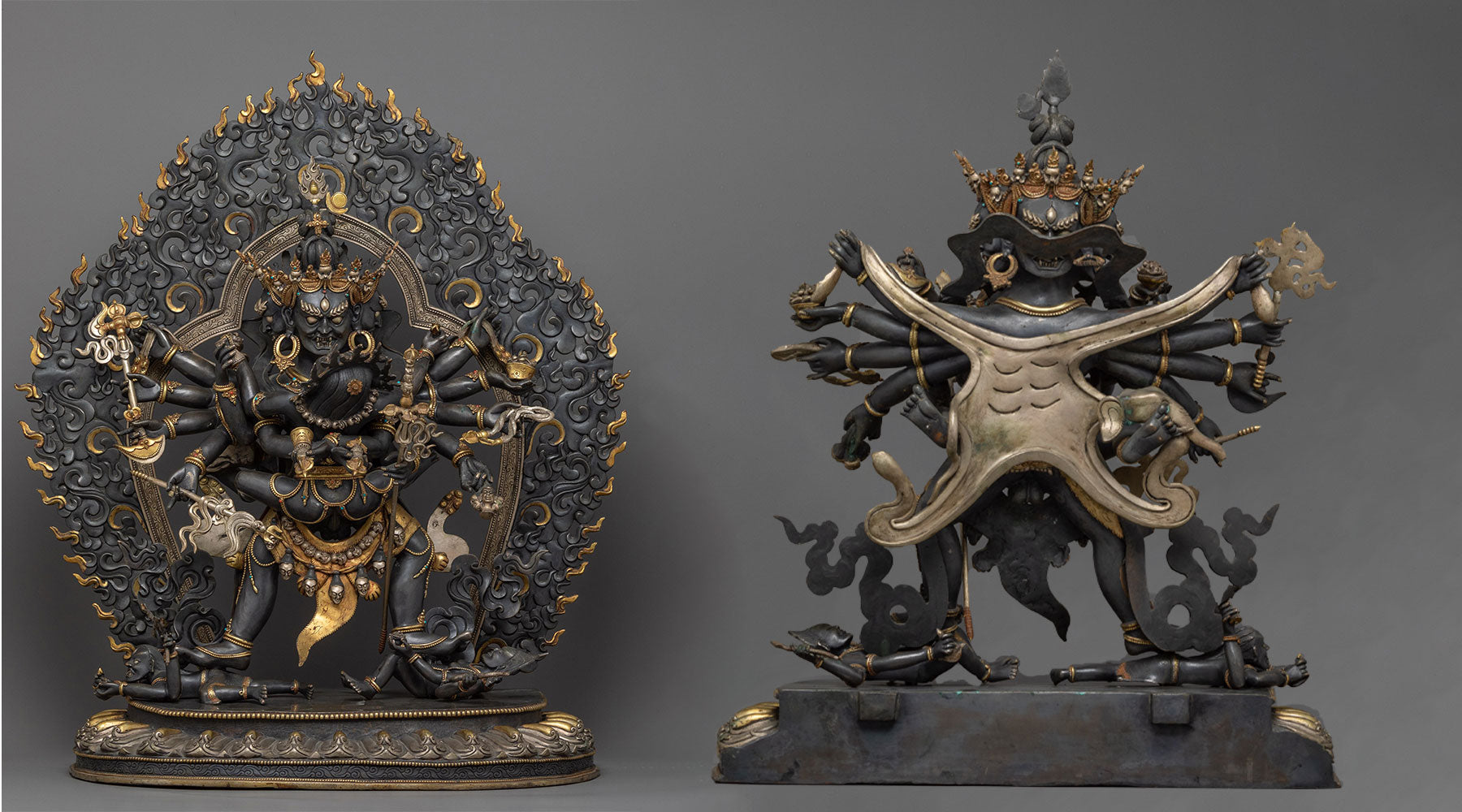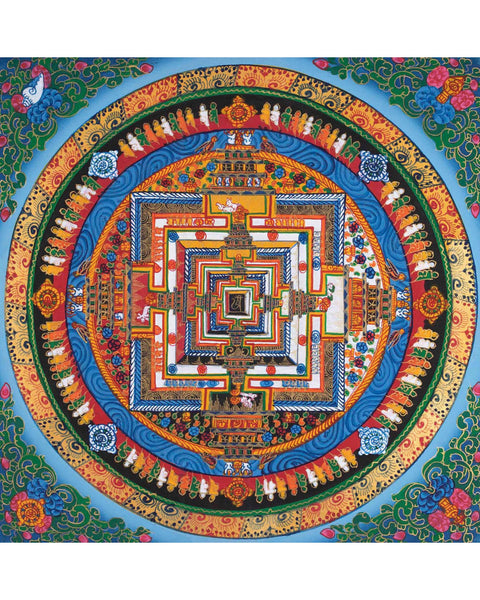Empower Your Path: Harnessing the Energy of Kalachakra for Spiritual Growth
The Kalachakra, meaning 'Wheel of Time' in Sanskrit, stands as a cornerstone within Tibetan Buddhism, embodying a comprehensive philosophy, an elaborate cosmology, and an intricate system of meditation and rituals. This teaching, pivotal to the Vajrayana tradition, provides a unique perspective on time, space, and the journey to enlightenment.
Key Takeaways:
- Kalachakra Tantra is a critical aspect of Tibetan Buddhism, emphasizing time and cyclical processes.
- It unifies concepts of cosmology, philosophy, and meditative practices.
- The Kalachakra initiation, often led by the Dalai Lama, is a significant spiritual event.
- The teachings offer a unique approach to understanding time and its spiritual implications.
Understanding the Kalachakra Tantra
History and Origin
The Kalachakra Tantra's origins trace back to the mythical kingdom of Shambhala and were introduced into Tibet around the 11th century. The lore states that the Buddha himself taught these practices. However, these teachings remained somewhat esoteric until the influential Tibetan Buddhist teacher Tsongkhapa, founder of the Gelug school, emphasized their significance.
Philosophical Foundations
This tantra stands out for integrating a myriad of Buddhist philosophical aspects. It not only presents an intricate cosmology, linking the macrocosm of the universe with the microcosm of individual human experience but also delves into the nature of reality, perception, and the interplay of the physical and spiritual realms.
Kalachakra's iconography and attributes, intricately detailed, symbolize the profound teachings of the Kalachakra Tantra in Tibetan Buddhism. Here's a concise overview:
Iconography of Kalachakra:
- Physical Appearance:Depicted with four faces, twenty-four hands, and dynamic legs, each element carries significant symbolism.
-
Faces:
- Black face: Destructive aspect of time.
- Red face: Preservative aspect.
- White face: Creative aspect.
- Yellow face: Growth and flourishing.
- Hands:Twenty-four hands holding symbolic objects representing various Buddhist teachings and practices.
- Two Legs:Dynamic posture symbolizing readiness to act, with one leg stepping forward, indicating progress.
- Ornaments and Attire:Adorned with symbolic ornaments, tiger skin skirt representing power and fearlessness.
- Consort:Often depicted with Vishvamata, symbolizing the integration of method and wisdom in Vajrayana Buddhism.
Kalachakra and Vishvamata: Symbolism of Wisdom and Method

Click here to view Kalachakra Gold Statue
In the intricate tapestry of Tibetan Buddhism, Kalachakra and his consort, Vishvamata, emerge as profound symbols embodying the union of wisdom and method—fundamental principles in Vajrayana practice. Beyond being divine representations, this mystic pair serves as a metaphor for the journey to enlightenment and the harmonious equilibrium of masculine and feminine energies in the cosmos.
Kalachakra: The Cosmic Chronometer
Termed the "Wheel of Time" in Vajrayana tradition, Kalachakra is a complex deity representing time and cycles on cosmic and individual scales, elucidating the process of spiritual evolution. His intricate form, as previously delineated, serves as a tapestry symbolizing various facets of Buddhist philosophy and cosmology.
Vishvamata: Consort of Kalachakra
Vishvamata, translating to "Mother of All," acts as the consort of Kalachakra, embodying the wisdom facet of the practice. In iconography, Vishvamata harmoniously unites with Kalachakra, symbolizing the inseparable nature of wisdom (the female principle) and method or compassion (the male principle).
Attributes of Vishvamata:
- Appearance:Often portrayed with a golden-hued body, symbolizing the purity and luminosity of wisdom.
- Four Faces and Eight Arms:Each face and arm denotes distinct aspects of wisdom and diverse means of aiding sentient beings.
- Holding Implements:Vishvamata's hands bear symbolic objects, including a lotus, mirror, and book, each representing facets of enlightened wisdom.
Symbolism in Union:
- Non-Duality:The union of Kalachakra and Vishvamata epitomizes the non-dual nature of reality, where wisdom and method, emptiness and bliss, seamlessly converge.
- Enlightenment:Serving as a metaphor for enlightenment, this union transcends all dualistic perceptions.
- Balance:Symbolizing the equilibrium of masculine and feminine principles, pivotal for the spiritual journey and the realization of Buddhahood.
Kalachakra's Unique View on Time and Space
- Concept of Time
In Kalachakra, time is not linear but cyclical, echoing natural processes and cosmic cycles. This perspective is pivotal for understanding the flow of existence and navigating the path to enlightenment. It challenges the conventional view of time, offering a more holistic and interconnected understanding of life's journey.
- Cosmology and Astronomy
The Kalachakra Tantra's cosmology is elaborate, including a distinct system of astronomy. It intricately describes the physical universe, aligning celestial and terrestrial phenomena with the human body and consciousness, suggesting a profound unity and interdependence among all levels of existence.
Meditation Practices in Kalachakra
- The Six Yogas
Central to Kalachakra practice are the Six Yogas – a sequence of advanced meditation techniques aimed at realizing the subtle energies within the body. These practices are designed to facilitate profound spiritual experiences and realization, leading ultimately to the state of enlightenment.
- Deity Yoga
Deity Yoga in the Kalachakra involves intricate visualization practices, focusing on the deities of the Kalachakra mandala. This meditative process is essential for embodying the qualities of enlightenment and forging a deep connection with the teachings. It represents a transformative journey from mundane consciousness to enlightened wisdom.
The Role of Rituals and Symbolism
- Rituals in Practice
Rituals in the Kalachakra tradition are not mere formalities but integral to the spiritual path. They serve as a means to internalize the teachings, acting as a bridge between the ordinary experience and the sacred, guiding practitioners in their spiritual journey.
- Symbolism of the Mandala

The Kalachakra mandala is a richly symbolic representation, embodying the deity, his pure land, and the entire cosmology of the Kalachakra. This mandala is not just a visual aid; it is a spiritual tool, encapsulating the essence of the teachings and serving as a focal point for meditation and realization.
|
Aspect |
Details |
|
Origin |
Shambhala, introduced to Tibet in the 11th century |
|
Key Figure |
Tsongkhapa, founder of the Gelug school |
|
Initiation |
Led by figures like the Dalai Lama |
|
Focus |
Time, cycles, cosmology, meditation |
|
Meditation Practices |
Six Yogas, Deity Yoga |
|
Symbol |
Kalachakra Mandala |
|
Modern Relevance |
Addresses peace, harmony, environmental balance |
|
Global Influence |
Affects art, psychology, peace movements |
The Kalachakra Tantra, with its rich philosophy, intricate practices, and universal relevance, stands as a beacon of wisdom in the Buddhist tradition. Its teachings on time, space, and enlightenment continue to inspire and guide practitioners in their spiritual journeys, transcending cultural, temporal, and geographical boundaries, and speaking to the core of the human experience in search of meaning, harmony, and peace.




